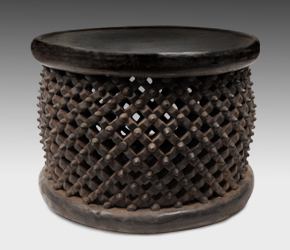 |
|
"Bamileke stools and throne chairs depict ancestors or their intermediaries; the most famous and copied type depicting spiders, a creature serving as the link between the living and the dead because it burrows into the ground"
Almost a century has passed since Matisse, Braque, Picasso, and Vlaminck brought African art into the awareness of the West. Since then, African tribal art has not ceased to arouse interest, and it has now found a secure place in the pantheon of world art. In embarking on a study of African furniture one is almost immediately confronted with the idea that across the continent the tribal peoples did not have a vast furniture repertoire. In other words, they did not make armoires, desks, wardrobes, dressers, and so on (in the western sense). Instead, they made seats, and in this single category they exhibited an almost limitless repertoire.
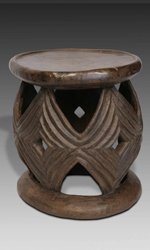 |
|
| |
|
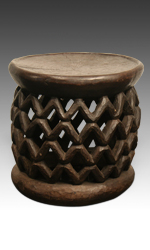 |
|
| |
African seats have exceptional sculptural power; and they range from items incorporating carved figures to extraordinarily abstract forms of a minimalism astonishing even by western standards. Stated simply, in Africa there is an almost endless variety of seats. Each particular group across the continent appears to have a seat endemic to itself, and within a particular style, a wide range of motifs referencing the status and rank of the household where it was found or the individual who used it.
The Bamileke are native peoples living in three regions of Cameroon, namely West, North-West and South-West. Today, they number almost 1,000,000 people, the largest communities or settlements ranging in size from 50,000 to 100,000, collectively known as the Bamileke Kingdom. Bamileke settlements follow a well organized and structured pattern; and these settlements are organized as chiefdoms, each chief known as a fon. The fon is considered the spiritual, political, judicial and military leader of the chiefdom and is thus accorded great respect. Some Bamileke groups also recognize sub-chiefs, or fonte. The artistic production of the Bamileke is closely associated with royalty and the ceremonies they conduct. Large figures, prestige objects, and thrones are commonly used by the fon and fonte to assert power and demonstrate their place in society.
A person's place in the royal hierarchy dictated the type and number of pieces they used; and most art depicts the position of its owner in this hierarchy. For example, in a chief’s residence one would find ancestral figures and masks, headdresses, bracelets, pipes, necklaces, swords, horns, fans, elephant tusks, leopard skins, terracotta pots, dishware, and thrones, all used to assert the chief’s power. In the home of a fonte one might find similar objects, but fewer in number and of less importance. In the home of a non-royal dignitary, one would also find a range of objects, but more utilitarian in nature. All of these objects were put to use during rituals such as funerals, festivals, and a host of ceremonies and rituals related to numerous societies found within the Bamileke kingdom, ceremonies and rituals conducted by royals and non-royals alike.
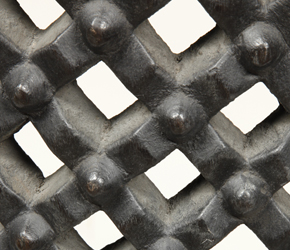 |
 |
One must look into the religious practices of the Bamileke to fully understand their culture and art, which includes furniture pieces such as this marvelous articulated stool, or throne. To the Bamileke, ancestor veneration is one of the most integral aspects of society. Like many other African tribes, they believe past generations are capable of providing guidance to the living if they can be heard, and for the Bamileke, communication with the ancestors is done primarily through “sages,” or medicine men. One important Bamileke belief is that the ancestral world lies deep within the earth. In other words, the earth is the home of the ancestors, the place where the deceased continue to live. Consequently, many Bamileke stools and throne chairs depict ancestors or their intermediaries; the most famous and copied type depicting spiders, a creature serving as the link between the living and the dead because it burrows into the ground.
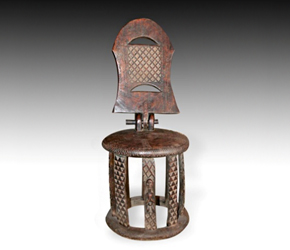 |
|
| |
|
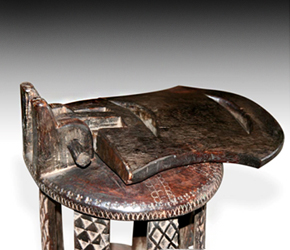 |
|
This particular throne (left) is unique in several respects. First, the back is articulated, removable and distinctly shaped; second, a figure appears on the central post; and third, geometric patterns dominate the piece, whether they are carved or incised. The removable back (and manageable size) suggests the piece was portable, intended to be carried from one place to another, most likely for official or semi-official functions because the back allows the piece to be characterized as a throne instead of a stool. The shape of the back is also unique, loosely referencing the shape of a shield. The single figure on the face can be characterized as an "ancestor," and the appearance on a supporting post can be interpreted as the sentiment, "we sit on those who have come before." Finally, the dominant geometric patterns – the triangle pattern and the cross-hatch pattern – in Bamileke art are said to represent stylized leopard spots, the leopard being a royal symbol of power and mastery in the Bamileke kingdom. Most interesting and worthy of note is the incising on the seat, which features stylized X's around and on pathways leading to a central circle where the X's congregate. In Bamileke art, the X is one of the accepted ways of depicting the spider, a symbol of divine knowledge as well as the link between the physical world and the ancestors.
So why was this stool created and who put it to use?
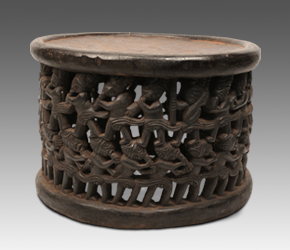 |
|
As noted earlier, within the Bamileke kingdom numerous societies are found. For example, the Kuosi Society belongs to the royal courts and enforces the laws of the kingdom. Nobles aid the fons and can be members of the Nkam be'e, the council of nine highest elders. There is warrior societies called the Mandjo composed of young men; and there is the Mkem, composed of men who have rendered service to the kingdom in one fashion or another. Each member of the Mkem, in turn, is also the head of a society with specialized functions and obligations extending into the areas of religion, economics and the military. Members of the Mkem may include warriors or businessmen, nobles or commoners whose activities have enriched the royal treasury, and their activities often require them to travel to execute their official duties. This highly stratified system of societies with various levels of nobility at the top, followed by royal retainers and accomplished commoners are responsible for maintaining continuity in the Bamileke kingdom.
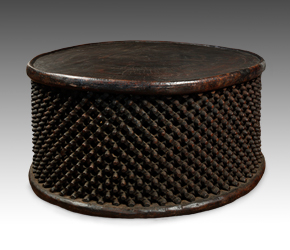 |
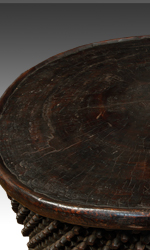 |
Although the Bamileke are renowned as skilled craftsmen, in recent times many traditional arts and crafts have been abandoned, resulting in far less diversity of furniture styles, making it difficult to precisely identify this throne. Royal stools and thrones are typically beaded and adorned with additional ornamentation such as cowrie shells or coins, and they were not made to be easily transported. One could ornamentation such as cowrie shells or coins, and they were not made to be easily transported. One could say, the ceremonies traveled to royalty, not the other way around. Nonetheless, this piece references royal symbols such as the leopard and spider, suggesting it was used in the conduct of some sort of official business. The piece also references a military affiliation because of the stylized back; and most importantly, the ancestors because of the figure on the front and the seat design, which can be interpreted as pathways leading to the ancestral home. Was the piece used by a diviner or sage, someone capable of interpreting advice given by the ancestors? Did it belong to a member of the Mkem; to a warrior? All of this is possible; but what is probable is that it belonged to a member of another society, the Kwifo, the policing society (also known as the "night" society) who act as agents of the fon to mediate significant conflicts, make decisions and pronounce sentences. If this is so, then this throne belonged to an authority who was acting in an official capacity to craft an agreement, settle a dispute or pass judgment.
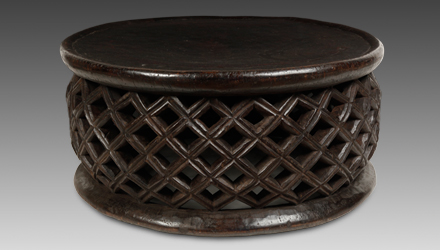
|
|
| |
|